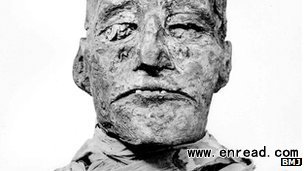基于一项新的法医分析,专家相信,埃及国王拉美西斯三世被反叛者切断喉咙杀死。
 slit2 in the throat" style="cursor:pointer" onclick="window.open('/upimg/allimg/121218/1_121218083248_1.jpg')" />
slit2 in the throat" style="cursor:pointer" onclick="window.open('/upimg/allimg/121218/1_121218083248_1.jpg')" />
The mummy of Ramesses III had a deep slit in the throat
The first CT scans to examine the king's mummy reveal a cut to the neck deep enough to be fatal.
The secret has been hidden for centuries by the bandages covering the mummy's throat that could not be removed for preservation's sake.
The work may end at least one of the
controversies5 surrounding his death.
Precisely6 how he died has been hotly debated by historians.
Ancient documents including the
Judicial7 Papyrus8 of Turin say that in 1155BC members of his
harem(闺房里的妻妾群) attempted to kill him as part of a palace
coup9.
But it is less clear whether the
assassination10 was successful. Some say it was, while other accounts at the time imply the second Pharaoh of the 20th dynasty survived the attack, at least for a short while.
The Judicial Papyrus tells of four separate trials and lists the punishments dished out to those involved in the plot, which included one of the king's two known wives, called Tiye, and her son Prince Pentawere - potential heir to the throne.
It says Pentawere, the only one of Ramesses III many sons to
revolt against(反感,厌恶) him, was involved in the
conspiracy12, found guilty at trial and then took his own life.
To find out more, Dr Albert Zink, a paleopathologist at the Institute for Mummies and the Iceman in Italy, and colleagues set out to examine the mummy of Ramesses III and the unidentified
remains13 of another body found in a royal tomb near the Valley of the Kings in Egypt that was believed to be the king's son Pentawere.
Working out of the Egyptian Museum in Cairo where the bodies are now housed, the team ran some CT scans and
DNA14 tests on the mummies.
Scans of Ramesses III revealed a deep, 2.7in (7cm) wide wound to the throat just under the larynx, which the medical scientists say was probably caused by a sharp blade and could have caused
immediate15 death.
 slit2 in the throat" style="cursor:pointer" onclick="window.open('/upimg/allimg/121218/1_121218083248_1.jpg')" />
slit2 in the throat" style="cursor:pointer" onclick="window.open('/upimg/allimg/121218/1_121218083248_1.jpg')" /> 收听单词发音
收听单词发音 


